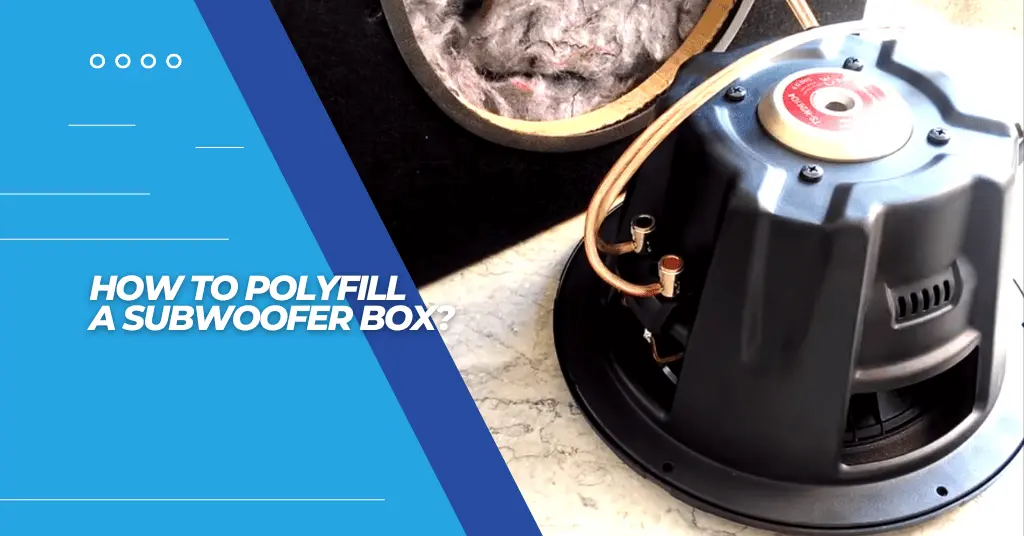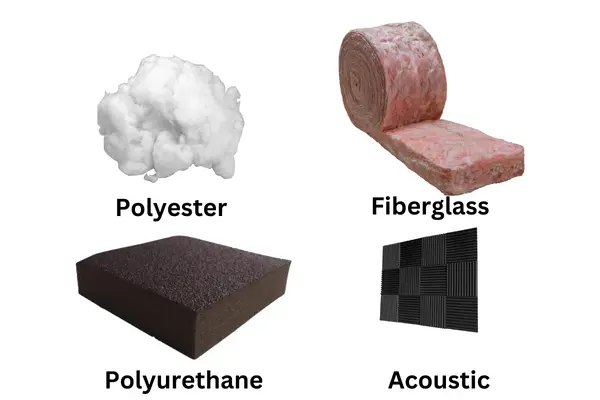How to Polyfill a Subwoofer Box?

Polyfill is an essential material for a box to produce a deep and loud bass sound. I really suggest adding an efficient amount of poly-fill to my clients, whether they use ported or sealed enclosures. However, the primary benefit of adding poly-fill is that it helps reduce standing waves and resonances inside the sub-box.
Well! We’ll discuss more of the benefits below. And now you may be wondering how to polyfill a subwoofer box. As a subwoofer expert, I would say it’s pretty simple, like cutting a piece of cake. So let’s begin the tutorial.
What Is a Polyfill & Its Types?
A polyfill is a synthetic material that audiophiles use to fill the empty space inside the subwoofer enclosures to dampen the sounds, resulting in improved sound. Furthermore, polyfill helps give a cleaner, deeper bass response from your subwoofer. It also prevents rattles, resulting in an enjoyable sound quality.
Poly-fill causes air spring within the enclosure to change from being adiabatic to an isothermal process ⁽¹⁾. In addition, it can help extend the sub’s life by reducing its exposure to dust particles that could damage its components. However, there are four types of polyfill that you can use for your subs’ enclosures:

- Polyester fiberfill: Most audiophiles use such a type to fill their enclosures. It’s lightweight, easy to put, and you can easily find them in your location.
- Fiberglass: It’s another common type that you can use for insulation. Like polyester, it’s also lightweight, easy to install, and can help dampen the sound waves efficiently.
- Polyurethane foam: Such type of poly-fill is flexible and commonly used in upholstery and bedding. It’s recommended if you want to reduce the vibrations of your sub-box.
- Acoustic foam: It is mainly used if you want your car audio system to absorb unpleasant sound waves.
According to my experience, I suggest you use a polyester poly-fill for your sealed subwoofer box.
Subwoofer Polyfill Calculator – How Much Should I Need?
The amount of polyfill for your subwoofer enclosure entirely depends on your ported or sealed sub-box size. For example, if you have an 8 cubic foot box, start with 1 1/2 to 2 bags of polyfill and, if necessary, add more in stages until you reach desired performance level. However, adding too much polyfill can produce a “choked-off” sound, so you must test every addition before adding more. Increasing air space within the sealed enclosure is also essential for quality bass output.
This is how much I use for my projects:
If you have an enclosure that has a size of 2 – 3 cubic feet, you should use about 1 and 1/2 poly-fill pounds to fill the enclosure. On the other hand, for enclosures greater than 3 cubic feet, you can reduce the pound to 1 per cubic foot of the box. However, you can use the below subwoofer polyfill calculator:
Subwoofer Polyfill Calculator
6. Steps to Polyfill a Subwoofer Box Successfully:
Below are some simple yet effective steps that can help you polyester polyfill a subwoofer enclosure to improve the sound:
1. Remove the Subwoofer’s Driver:
To remove the subwoofer driver from its enclosure, first, use a screwdriver to unscrew and remove the mounting screws that secure the driver. Next, carefully pull off the gasket attached to the speaker’s cone. Finally, separate any wires/connections until you can lift out your subwoofer driver without disruption.
2. Measure the Enclosure:
To measure the enclosure, you’ll need to multiply the box’s length x width x height to get its total internal volume in a cubic foot. Use an average wall thickness for all measurements if your enclosure is constructed from non-standard materials, such as curved walls or multiple pieces.
3. Calculate the Required Amount of Polyester Poly-fill:
You can use a subwoofer polyfill calculator to measure the required amount. Remember, you must carefully determine the amount before you fill the sealed enclosure with polyester or fiberglass to ensure it works correctly. If you overuse the material, it can damage your sound quality.
4. Cut the Polyfill Material:
Cutting the poly-fill into small pieces before installing it in a subwoofer box ensures easy installation and maximizes acoustic performance. Using scissors or a knife, you can cut the material into roughly 2 inches (5 cm) squares. After cutting, separate these squares into strips (if using fiberglass polyfill) approximately 1/2-3/4 inch (1-2cm) wide, ensuring all the pieces of polyfill are uniform.
5. Stuff the Polyfill:
Once you have followed all the above steps, it’s time to stuff the material into the box. Ensure you distribute it evenly throughout the ported or sealed enclosure. As mentioned above, you must not overstuff your container with the material as it can lead to damage.
6. Reattach the Subwoofer’s Driver:
Ultimately, you can reattach the driver with the subwoofer’s box. You can use the screwdriver to mount the screws to secure the sub. However, ensure you have connected the wires to the sub correctly so that you don’t have to remove the driver again to perform the action.
Benefits of Adding Polyfill Material in Subwoofers:
Here are some of the potential benefits of why using polyfill materials in enclosures:
1. Improve Bass Response:
Polyfill is a synthetic material that you can use to line the walls of a speaker enclosure. It helps to absorb waves and prevent them from bouncing off hard surfaces, which helps to reduce standing waves and resonances. Ultimately, you will get an improved bass response from the subwoofer. Poly-fill also has acoustic dampening properties, which help improve sound clarity by reducing reverberation and echo effects within the enclosure. The result is enhanced bass response with improved definition, punch, and accuracy.
2. Enhances Clarity:
Polyfill helps to reduce the distortion of waves inside a subwoofer enclosure. You will notice a clear sound as it can absorb the excess sound energy (responsible for bouncing around and artifacts). Furthermore, it allows for precise and more accurate audio reproduction with better imaging by dampening unnecessary reflections. Additionally, it can help improve low-frequency response and overall loudspeaker performance.
3. Increased Efficiency:
It reduces the number of reflected acoustic waves, allowing bass frequencies to reach listeners more effectively and producing a louder and clearer sound output with less wasted energy. In addition, poly-fill also helps create a tighter bass response by smoothing out any peaks or valleys in frequency response. As a result, it increases overall acoustic efficiency for improved sound quality.
Myths About Polyfill Filling:
Here are some common myths:
- The more the polyfill, the better: That’s not true. People believe adding too much amount of polyfill can improve the sound. However, it damages the quality of sound. Therefore, use the right amount for filling.
- It’s only necessary for sealed boxes: However, people think you can only use polyfill in ported boxes. Nope! You can also use it in ported subwoofer boxes for effectively damping the sound and distortion.
- It can fix all the enclosure problems: That’s also not true. If you are using a too-small or too-larger enclosure, it won’t work correctly. Also, if adding poly-fill doesn’t improve the sound, the problem may be elsewhere.
- You can use any polyfill type: Nah! You must evaluate your subwoofer enclosure type before choosing any polyfill material. For example, you can use fiberglass if your sealed box has holes in it.
- Only for audiophiles: Everyone should use this material to optimize the quality of the car audio system. So, if you’re an audiophile or not, you must use it for improvement.
General FAQs
Should I Put Polyfill in My Sub Box?
Yes, as an audio expert, I will suggest you put polyfill in your sub-box. Polyfill helps to fill in the empty space and can also help absorb waves that would otherwise be lost. It will provide a more balanced sound for your subwoofer and increase bass response. However, you must appropriately place the material for optimal performance, so read up on proper installation techniques before adding it to your subwoofer system.
Can Polyfill Damage a Subwoofer?
No, poly-fill does not damage a subwoofer. The material is an inert, lightweight foam-like material made from polyester fibers that provide sound insulation for enclosed spaces, including the inside of a subwoofer cabinet. It helps to minimize the interference caused by back waves and reflections. However, overstuffing the sub-enclosure can lead to damage. Therefore, always use the optimal amount.
What Is a Proper Way to Stuff a Sealed Subwoofer?
Properly stuffing a sealed subwoofer uses generalized acoustic absorbent material, such as fiberglass, polyester fiberfill, or rock wool insulation. This stuffing helps reduce port noise and bass peaks caused by standing waves inside the sealed box. Generally speaking, it’s recommended to fill between 25-50% of the enclosure’s internal volume with the acoustic absorption material for best results. It should also be evenly distributed around all six sides within the speaker box cavity to ensure an even bass response throughout your system.

I love the way you elaborate this entire feed thanks indeed for your submission👍🙏
Thank You! Geoffrey Tomusange
We’re glad you like it.
Thank you so much!
May I ask you, Where to buy Fiberglass?
Thank you!
You can order fiberglass from amazon. If you’re looking for a quality fiberglass that I use for most of my projects, here’s the link(This is an affiliate link – I’ll earn commission if you purchase through it.)